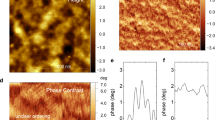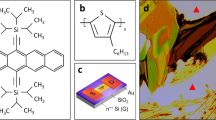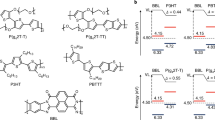Abstract
Organic materials offer new electronic functionality not available in inorganic devices. However, the integration of organic compounds within nanoscale electronic circuitry poses new challenges for materials physics and chemistry. Typically, the electronic states in organic materials are energetically misaligned with the Fermi level of metal contacts. Here, we study the voltage-induced change in conductivity in nanoscale devices comprising a monolayer of polyelectrolyte macromolecules. The devices are fabricated using integrated shadow masks. Reversible switching is observed between conducting (ON) and non-conducting (OFF) states in the devices. The open design of our devices easily permits chemical modification of the polyelectrolyte, which we show has a pronounced effect on the ON–OFF switching. We suggest that the switching voltage ionizes the polymers, creating a conducting channel of electronic levels aligned with the contact Fermi level.
This is a preview of subscription content, access via your institution
Access options
Subscribe to this journal
Receive 12 print issues and online access
$259.00 per year
only $21.58 per issue
Buy this article
- Purchase on Springer Link
- Instant access to full article PDF
Prices may be subject to local taxes which are calculated during checkout





Similar content being viewed by others
References
Collier, C. P. et al. A [2]catenane-based solid state electronically reconfigurable switch. Science 289, 1172–1175 (2000).
Stewart, D. R. et al. Molecule-independent electrical switching in Pt/organic monolayer/Ti devices. Nano Lett. 4, 133–136 (2004).
Ma, L. P., Liu, J. & Yang, Y. Organic electrical bistable devices and rewritable memory cells. Appl. Phys. Lett. 80, 2297–2299 (2002).
Ouyang, J. Y., Chu, C. W., Szmanda, C. R., Ma, L. P. & Yang, Y. Programmable polymer thin film and non-volatile memory device. Nature Mater. 3, 918 (2004).
Chen, J., Reed, M. A., Rawlett, A. M. & Tour, J. M. Large on–off ratios and negative differential resistance in a molecular electronic device. Science 286, 1550–1552 (1999).
Tseng, R. J., Ouyang, J., Chu, C. W., Huang, J. S. & Yang, Y. Nanoparticle-induced negative differential resistance and memory effect in polymer bistable light-emitting device. Appl. Phys. Lett. 88, 123506 (2006).
Brewer, J. E., Zhirnov, V. V. & Hutchby, J. A. Memory technology for the post CMOS era. IEEE Circuits Device. 21, 13 (2005).
Kozicki, M. N., Gopalan, C., Balakrishnan, M. & Mitkova, M. A low-power nonvolatile switching element based on copper-tungsten oxide solid electrolyte. IEEE Trans. Nanotechnol. 5, 535–544 (2006).
Tondelier, D., Lmimouni, K., Vuillaume, D., Fery, C. & Haas, G. Metal/organic/metal bistable memory devices. Appl. Phys. Lett. 85, 5763 (2004).
Zhitenev, N. B. et al. Control of topography, stress and diffusion at molecule-metal interfaces. Nanotechnology 17, 1272 (2006).
Philipp, G., MuЁller-Schwanneke, C., Burghard, M., Roth, S. & Klitzing, K.v. Gold cluster formation at the interface of a gold/Langmuir–Blodgett film/gold microsandwich resulting in Coulomb charging phenomena. J. Appl. Phys. 85, 3374–3376 (1999).
Peumans, P., Uchida, S. & Forrest, S. R. Efficient bulk heterojunction photovoltaic cells using small-molecular-weight organic thin films. Nature 425, 158–162 (2003).
Ma, W. L., Yang, C. Y., Gong, X., Lee, K. & Heeger, A. J. Thermally stable, efficient polymer solar cells with nanoscale control of the interpenetrating network morphology. Adv. Funct. Mater. 15, 1617–1622 (2005).
Harland, R. S. & Prud'homme, R. K. (eds) Polyelectrolyte Gels. Properties, Preparation and Application Vol. 480 (American Chemical Society, Washington DC, 1992).
Roiter, Y. & Minko, S. AFM single molecule experiments at the solid–liquid interface: in situ conformation of adsorbed flexible polyelectrolyte chains. J. Am. Chem. Soc 127, 15688–15689 (2005).
Strukov, D. B. & Likharev, K. K. CMOL FPGA: a reconfigurable architecture for hybrid digital circuits with two-terminal nanodevices. Nanotechnology 16, 888 (2005).
Ruhe, J. in Polymer Brushes (eds Advincula, R. C., Brittain, W. J., Caster, K. C., & Ruhe, R.) (Wiley-VCH, Weinheim, 2004).
Bialk, M., Prucker, O. & Ruhe, J. Grafting of polymers to solid surfaces by using immobilized methacrylates. Colloids and Surfaces A 198–200, 543–549 (2002).
Iyer, K. S., Zdyrko, B., Malz, H., Pionteck, J. & Luzinov, I. Polystyrene layers grafted to macromolecular anchoring layer. Macromolecules 36, 6519–6526 (2003).
Lai, Y. S., Tu, C. H., Kwong, D. L. & Chen, J. S. Bistable resistance switching of poly(N-vinylcarbazole) films for nonvolatile memory applications. Appl. Phys. Lett. 87, 122101 (2005).
Grabert, H. & Devoret, M. H. Single Charge Tunneling (Plenum Press, New York, 1992).
Zdyrko, B., Klep, V. & Luzinov, I. Synthesis and surface morphology of high-density poly(ethylene glycol) grafted layers. Langmiur 19, 10179–10187 (2003).
Brandrup, J. & Immergut, E. H. Polymer Handbook 3rd edn (Wiley-Interscience, New York, 1988).
Acknowledgements
We would like to acknowledge discussions with E. Chandross, J. Aizenberg, A. White and V. Zhirnov. A.S. was supported by the Office of Naval Research, Award N00014-05-1-0909.
Author information
Authors and Affiliations
Contributions
N.Z. and A.S. conceived and performed the experiments, D.T. and R.C. designed and fabricated the integrated masks.
Corresponding author
Ethics declarations
Competing interests
The authors declare no competing financial interests.
Supplementary information
Supplementary Information
Supplementary figures S1—S6 (PDF 788 kb)
Rights and permissions
About this article
Cite this article
Zhitenev, N., Sidorenko, A., Tennant, D. et al. Chemical modification of the electronic conducting states in polymer nanodevices. Nature Nanotech 2, 237–242 (2007). https://doi.org/10.1038/nnano.2007.75
Received:
Accepted:
Published:
Issue Date:
DOI: https://doi.org/10.1038/nnano.2007.75
This article is cited by
-
Implementation of Memristor Towards Better Hardware/Software Security Design
Transactions on Electrical and Electronic Materials (2021)
-
Neuromorphic nanoelectronic materials
Nature Nanotechnology (2020)
-
A Collective Study on Modeling and Simulation of Resistive Random Access Memory
Nanoscale Research Letters (2018)
-
DFT computational correlations on conformational barriers of Zn2+ and Ni2+ chiral meso-(α,β-unsaturated)- porphyrins
Journal of Molecular Modeling (2017)
-
Anatomy of vertical heteroepitaxial interfaces reveals the memristive mechanism in Nb2O5-NaNbO3 thin films
Scientific Reports (2015)



